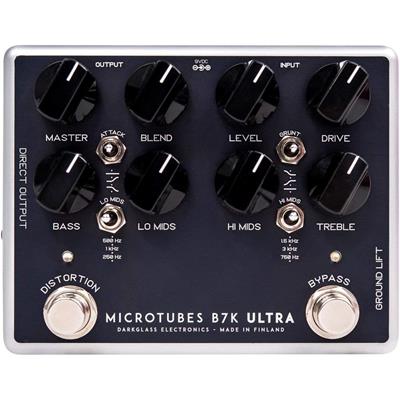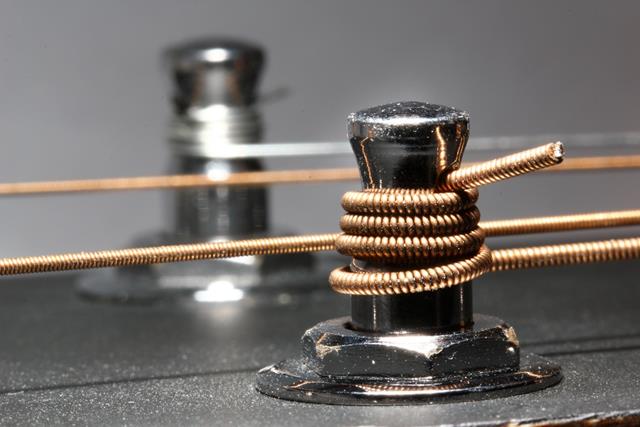We all know what an amazing effect distortion is. The way it thickens up your sound, adds girth to it, is completely irreplaceable. This is why it is so appreciated among so many musicians. Its versatility in terms of musical genres is also highly praised. But what happens when you distort the bass? That is my friend where the real magic comes into play. Your guitar starts to produce the sound you never thought was possible to achieve. Bass distortion is not for everyone, but those who are willing to risk and experiment will take things up in gear. This article will list some of the best bass distortion pedals on the market and will underline all the significant information you will need for this journey. If you are interested, just keep on reading in order to find the best suitable pedal for your needs!
Top 5 Best Bass Distortion Pedals
| Image | Amplifier Model | ||
|---|---|---|---|
 | Darkglass Electronics Micro tubes MTB7K-ULTRA |  (5 / 5) (5 / 5) | Check on Amazon |
 | Source Audio SA141 Soundblox Pro Multiwave Bass Distortion |  (5 / 5) (5 / 5) | Check on Amazon |
 | Boss BB-1X Bass Driver |  (4.9 / 5) (4.9 / 5) | Check on Amazon |
 | MXR M85 Bass Distortion |  (4.8 / 5) (4.8 / 5) | Check on Amazon |
 | Electro-Harmonix Nano Bass Big Muff Distortion Pedal |  (4.7 / 5) (4.7 / 5) | Check on Amazon |
Darkglass Electronics Micro tubes MTB7K-ULTRA

What we got here can be called a full package. As soon as you plug in B7K Ultra you will discover the whole new world of sounds. This badass pedal is equipped with 8 knobs, 4 toggle switches and 2 footswitches. B7K is very versatile and functional. From left to right we have Master, Blend, Level, Drive, Treble, Hi Mids, Bass and Lo Mids knobs. Lo Mids has 1 toggle switch with 3 different frequencies: 250 Hz, 500 Hz and 1 kHz. The drive knob controls the strength of drive. Treble and Bass are used to balance EQ. Blend and Level knobs help you to experiment with dry and wet sounds and actually mess things up. Hi Mids also comes with 1 toggle switch, with frequencies: 750 Hz, 1.5 kHz and 3 kHz. The master knob is the star of the show as it unites all the effects. Last but not least, we have Attack and Grunt switches. Those work with high/low music signals. When you use the Bypass footswitch you can explore sounds before distortion and then add some of that too. In short B7K Ultra gives you an awesome platform for unique sounds, all you have to do is tune the knobs and let the music flow.
Pros:
- Very functional
- Delivers clear sounds
- Extremely versatile
Cons:
- Bit expensive
- Toggle switches are not easily accessible
Source Audio SA141 Soundblox Pro Multiwave Bass Distortion

Soundbox Pro is the pedal adapted to bass guitar frequency range. This fella does real magic. After connecting it to your guitar you can easily mix chords and distortion. Pedal has 23 distortions, EQ, Clean Mix, Drive, and Distortion knobs. Distortion is changed from normal to foldback and octave for more aggressive and deep sounds. The abovementioned knobs control the intensity and clarity of the tone. Soundbox Pro expands the sound palette on your bass. What is more, the pedal processes multi-band and single band frequencies and is great for stage or even studio performances. This unit has two banks of three presets so that your masterpieces will not be lost. They are equipped with LEDs that indicate which bank is active. You may have some doubts regarding the effectiveness of this multifunctional device, but trust me, when you plug it in you will become the sorcerer of music and be able to create very unique and versatile sound.
Pros:
- Multiple features
- Ease of use
- Multiband processing
Cons:
- Big in size
Boss BB-1X Bass Driver

When you first see BB-1X you may wonder what this small device can offer to a professional guitar player, but Boss always manages to create pedals with compact design and optimized features. The first good thing about this unit is its size. The features are very easy and clear. BB-1X has 4 knobs: Level, Blend, High and Drive. Level, Blend and Drive balance and adjust the frequencies of your tone, while Blend shapes the affected sound with direct. Despite the fewer features, Boss has created the pedal that can deliver both clean and the dirtiest tones you might have thought of. Shortly BB-1X is the most distorted and spoilt pedal you may use for your sounds. Just try it for once and you will find love from first sight. Nice, right?
Pros:
- Wide range of sounds
- Compact size
- Durable
Cons:
- Balanced output uses ¼ TRS jack instead of XLR
- Gets a little crazy at higher settings
MXR M85 Bass Distortion

If you are a distortion addict, MXR M85 is what you want to add to your pedalboard. This little beast is extremely simple to use and very versatile at the same time. It can deliver the dirtiest chords and has 4 knobs which were perfectly combined by bass dirt guru Ryan Ratajski. Wet and dry knobs control the level of the tone and their separate existence makes pedal very unique. By setting these 2 knobs on noon they become soulmates of the tone and sound more than perfect. MXR M85 has LED/SIL switch, the latter shapes deep and aggressive tones and the former delivers lighter ones, on the contrary. Tone and Dist knobs are quite self-explanatory. They manage tone intensity and distortion level. All in all, if you are bassist looking for over-the-edge sounds then you have your winner.
Pros:
- Separate knobs for wet and dry signals
- Solid body
- Quality sound
Cons:
- Not for everyone
Electro-Harmonix Nano Bass Big Muff Distortion Pedal

Proud offspring of its ancestors Nano Bass Big Muff combines the design and tonality of other Electro-Harmonix pedals. Its simplicity is very comfortable. This pedal has three knobs: Tone modifies the range of your sound, Vol controls the overall output of the device, while Sustain provides you with silky and unique tones. Additionally, Nano Bass Big Muff has a toggle switch that controls the dryness/wetness of your signal while experimenting with distortion. There is more: this pedal is so small it will fit even on the most overcrowded pedalboard. Whether you want to play dirty blues or some classic rock, just set the knobs on the right level and start playing. With Nano Bass Big Muff you can achieve even the nastiest tones. Clear sonority and amazing distortion fulfills the sound and creates real harmony.
Pros:
- Compact design
- Easy to use
- Powerful and clear sound
Cons:
- Dry signal knob has limited options
In my book, the most mesmerizing things happen when you think out of the box. Yes, you can definitely achieve amazing results by sticking to the traditional ways of doing things, but the results you get with unconventional thinking are a totally different story. That is the prime reason why I love bass distortion pedals. At first glance, you might be sure that it will not work. But in reality, it works wonders. Bass is as suitable for distortion and overdrive as an electric guitar, it just needs more attention to detail. And this kind of setup is not limited to metal or rock either (even though Black Sabbath, Motörhead and others have nailed it to perfection). If you use the right settings, bass distortion pedals can be used with any genre. After all, no one can tell you what to do. If you want to employ this unit in a pop song, you should definitely go for it. I would recommend this pedal, particularly to those who are always the stars of any show, because there is no chance you would not stand out with your distorted bass sounds.
Since achieving the right effect with bass distortion is not a piece of cake, there are a lot of things to consider. I will try to break it down for you and discuss every issue related to this subject. The main things you should always keep in mind are the ways of utilization, your frequencies and the things that make up a badass bass distortion pedal. So, let’s dive into this amazing world of girth.
Bass guitar vs electric guitar distortion pedals
Now that we know that bass works with distortion, there is one small detail left to discuss. For this we should emphasize that there is a huge difference between bass and electric guitars. The reason why their sound is so distinguishable is that these two have diverse frequency spectrums. Bass guitar produces low end frequencies, while electric creates a higher-pitched sound. This means that the pedals you use with them should have the corresponding frequency response. While you can find an electric guitar distortion pedal that will also work with bass, the results you will get with a bass distortion unit will be way more precise and dimensional. If you already own this effect, you could try it with bass and see how it works. Only after can you be sure that you need a specific pedal for your bass guitar. In my opinion, narrowing things down is always a good choice.
The features a good bass distortion pedal should have
If you have taken a good look at the list above, you would have noticed that most of the pedals have several things in common. These are the exact features that a good bass distortion should have. I always like to say that more is more. The more parameters you control, the better the results. When you are able to tweak all the small details lingering in your sound, you receive something that is extremely precise and tailored to your desires. Without further ado, let’s dig into all the must-haves. The first and probably the most significant one is the frequency response. As I have already mentioned, a good pedal should have the option of choosing the bass frequencies, otherwise, it will not make any sense. The second one is some kind of EQ. The ability to manage high, low and midranges has a substantial impact on the overall results. And finally, a good pedal must possess a blend knob. This feature is important for almost every effects pedal and distortion is no exception. It is true, though, that sometimes even a single knob will provide you with a badass sound, but having some options never hurts anybody.
Some tips on dialing a good bass distortion
As with almost anything with bass, dialing a badass distortion is not an easy job either. Even though I just said that more is more, this is the case where less is more. You have to be careful with the settings you dial in to get the best results. As you know, bass and other guitars in the band should be balanced so that the overall sound is even. You do not want to get lost in the mix either. In order to achieve this, you should not necessarily pump your gain to its maximum settings (this is the very reason why you might be too similar to other distorted signals in your band). The main player here is the blend knob. As it balances out your dry and affected signals, your sound will be smoother and maintain its integrity, as well as all the unique qualities. Another way of making sure that your bass distortion is perfectly audible is to use separate lines, but this is a bit more difficult. Just tweak the knob on your pedal and you will be good to go.
Conclusion
Congratulations, my friend, you have made it till the end. I hope you enjoyed your ride. I tried my best to give you all the information you will need to choose the best bass distortion out there. However, my involvement ends here. I will leave you one last note: DO NOT be afraid to experiment. Even if you are playing something as picky as bass, there is always a way to find new combinations that work wonders. Enjoy every moment of your performance and always play for own enjoyment. The more affectionate you are about your sound, the better the public will understand what you are striving for. As with bass distortion, always look forward to finding the best sound for you, because that is exactly how innovations happen. I truly believe that choosing the best bass distortion will be a bit easier for you. I wish you the dirtiest sound and the girth of your dreams. Good luck!





